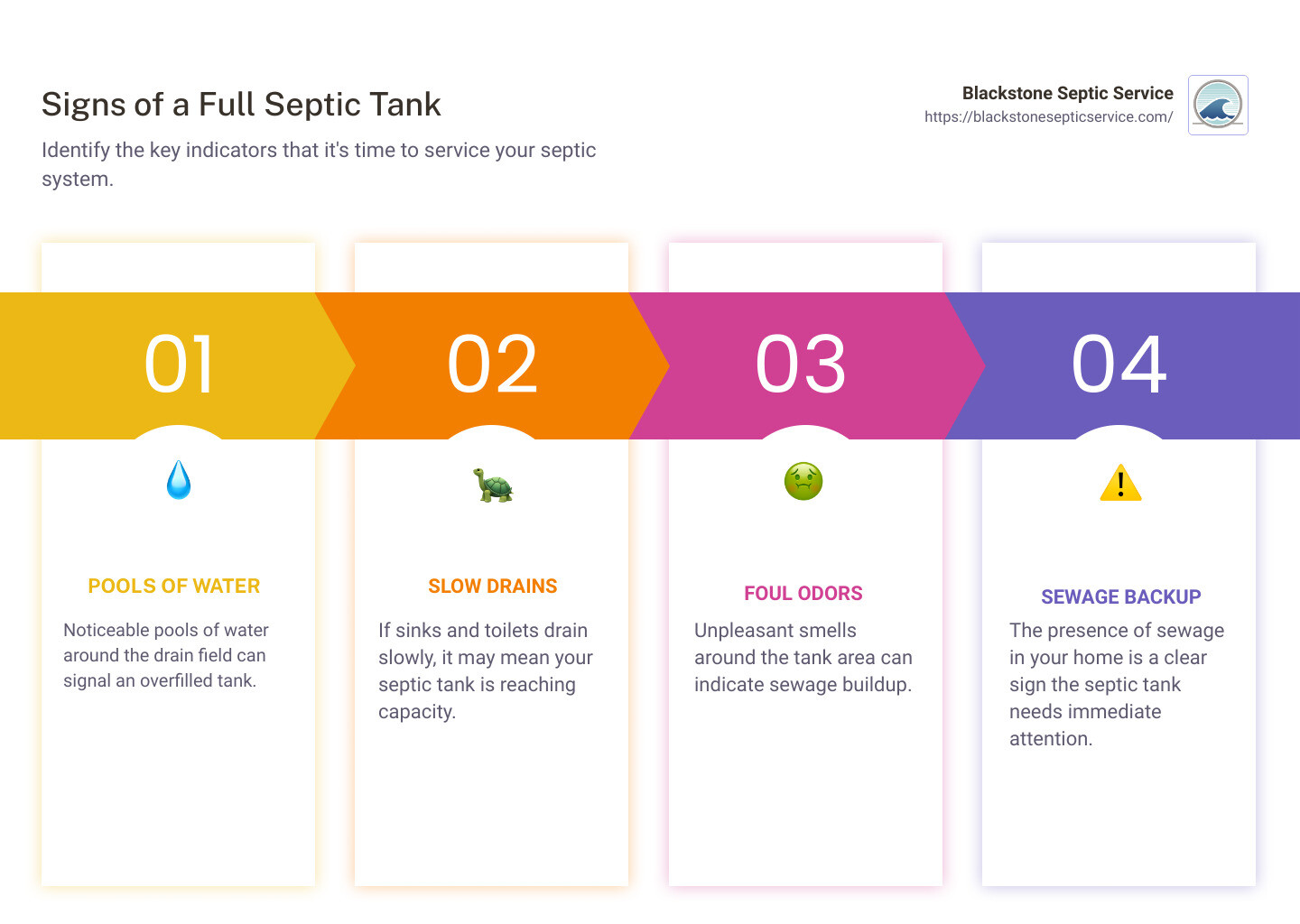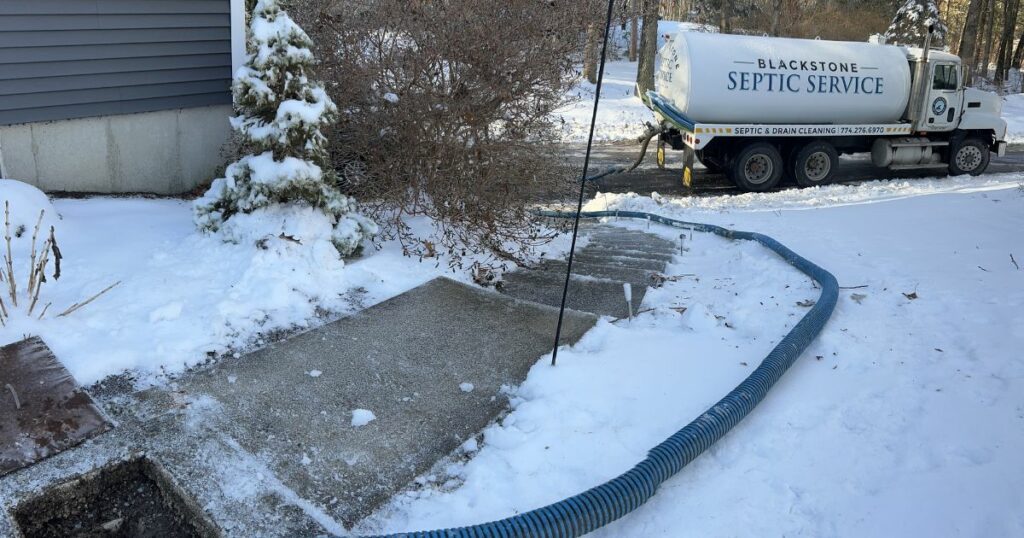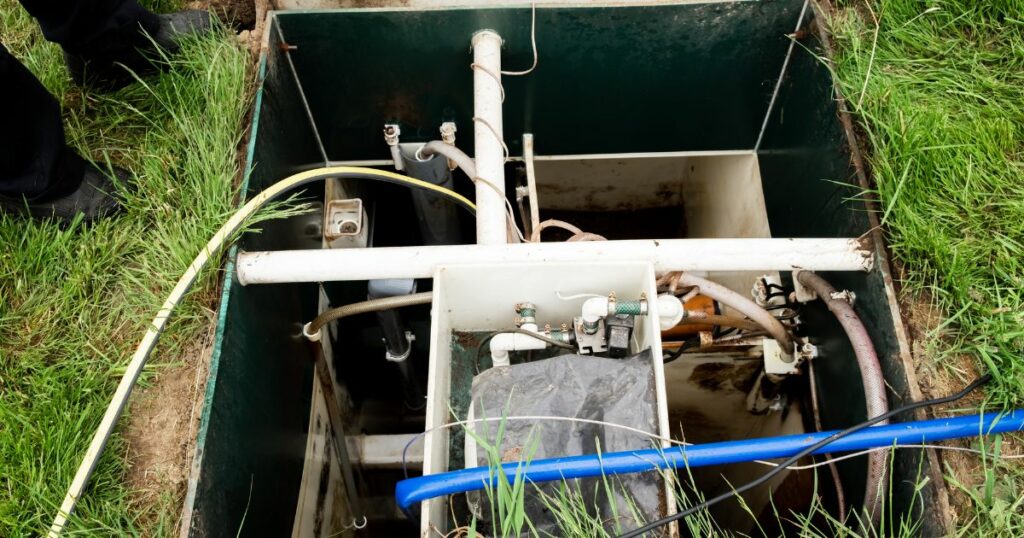Is a foul smell coming from your lawn? Are you experiencing slow drains or trouble flushing your toilets? These might be signs that you are dealing with a vital question many homeowners face: “How do you know when your septic tank is full?” A full septic tank is more than just a minor inconvenience – it can create significant health hazards and cause serious damage to your plumbing system.
At Blackstone Septic Service, we understand the serious implications of a full septic tank and the immediate attention it requires. We know the discomfort associated with foul odors and slow drains that keep reminding us of the underlying issue. That’s why it’s important to be aware of the signs indicating a full septic tank and act promptly to mitigate the risk of severe plumbing issues.
Here are the key signs that indicate a full septic system:
- Pools of water around your septic tank’s drain field
- Slow-draining sinks, bathtubs, or toilets
- Foul odors around your septic tank
- Lush, green grass growing over your septic tank
- Backups or overflow of sewage into your home

Understanding these signs and knowing your next steps could save you a significant amount of money, time, and discomfort in the long run. In the following sections, we’ll walk you through these telltale signs in more detail, along with practical solutions to help you manage a full septic tank effectively. Let’s dive in!
Table of Contents
Understanding Septic Tanks: A Brief Overview
If you’re new to septic tanks, you might be wondering, “is my septic tank full??” But before we delve into the signs of a full septic tank, understand what a septic tank is and how it works.
A septic tank is a crucial part of a private sewage treatment system, commonly found in properties that aren’t connected to a city’s main sewage pipes. This underground tank receives all wastewater from your home, including everything from your bathroom, kitchen, and laundry drains.
Once the waste enters the tank, it undergoes a process of separation. The solid waste settles at the bottom, forming a layer of sludge, while oils and grease float to the top, forming a layer of scum. Between these two layers is a relatively clear liquid layer, known as effluent.
This effluent gradually flows from the tank into a drain field (also known as a leach field), where it gets naturally filtered through the soil. Meanwhile, the solid waste in the tank gets broken down by bacteria and should ideally be pumped out every 2-5 years.
However, if the tank isn’t properly maintained or if something disrupts the system, it can lead to a build-up of sludge, causing the tank to fill up and potentially overflow. To prevent such problems, it’s crucial to understand the signs of a full septic tank and take action promptly.
At Blackstone Septic Service, we’re here to guide you through the process and provide professional septic services to ensure your system runs smoothly. In the next section, we’ll explain the three different definitions of a “full” septic tank.
The Three Definitions of a “Full” Septic Tank

When it comes to understanding if your septic tank is full, it’s important to know that “full” can mean different things depending on the context. Let’s dive into the three definitions of a “full” septic tank.
Normal Level
A septic tank’s normal level refers to the amount of waste it’s designed to hold. Under normal operation, waste flows into the tank, and wastewater exits it without any issues. After pumping, the tank is emptied, but as it gets used, it returns to its normal level of “full”. This is the standard operation and doesn’t indicate any issues with your septic system.
Accumulation of Sludge
Over time, the solid waste in your septic tank can accumulate and form a layer known as sludge. This sludge builds up at the bottom and doesn’t disappear on its own — it needs to be removed. While wastewater continues to flow out to the drainage field, the building sludge can cause issues if not addressed. This state of “full” is more problematic and usually requires professional septic tank cleaning, something we at Blackstone Septic Service specialize in.
Overfilled Tank
The third definition of a full septic tank is when your tank is overfilled. This happens when the drainage field stops accepting water, which can cause water to back up into the overflow tank. The water level will rise to the very top of the tank’s capacity, which can lead to serious issues like sewage backups and leaks. If you suspect your septic tank is overfilled, it’s crucial to contact a septic service professional immediately.
Understanding these three definitions is key to managing your septic system effectively. Regular septic tank maintenance can help prevent sludge accumulation and overfilling. The team at Blackstone Septic Service is always here to help with your septic tank needs. Next, we’ll discuss the seven indicators that your septic tank is full and needs attention.
The 7 Indicators Your Septic Tank is Full
Now that we understand what it means for a septic tank to be full, let’s delve into the signs that can help you identify when your septic tank is at capacity. Here are the seven key indicators that you should be aware of:
Pools of Water Around the Drain Field
The first sign to watch out for is the presence of standing water around your septic tank’s drain field. This is a clear indication of an overflowing septic tank. If the weather has been dry and you notice pools of water, this is a strong sign that your septic tank is full and needs to be emptied.
Slow Drains or Difficulty Flushing
Slow draining sinks, bathtubs, or toilets can be a sign of a full septic tank. If you observe that your drains are clearing slowly or there’s difficulty flushing your toilet, it could mean that your septic system is either clogged or full. It’s important not to ignore these signs. If the problem persists even after using a septic-friendly drain cleaner, it’s time to call in the professionals for septic tank service.
Foul Odors
Bad smells are a clear indicator that something is wrong with your septic tank. If you start noticing foul odors around your septic tank area, it’s likely that your tank might be full or nearing capacity. It could also indicate a leak in the system, so it’s best to get it checked out as soon as possible.
Healthy Grass Above the Tank
While lush, green grass might be a desirable sight for many homeowners, it could be a warning sign if it’s located above your septic tank. If the grass in this area appears healthier and greener than the rest of your lawn, it might be due to an overflowing septic tank. Be sure to monitor this area and call for service if you notice such changes.
Water Coming Out of the System
If you observe water leaking from your septic system, it’s a strong indication that your tank is full. Whether it’s a slow leak or a sudden gush of water, don’t ignore this sign. It’s time to get your septic system inspected and serviced.
Sewage Backup
This is one of the most obvious and severe signs of a full septic tank. If you notice raw sewage backing up into your home, it’s critical to call a professional septic service immediately. This situation can cause damage to your home and pose health hazards, so it’s best to act fast.
Gurgling Sounds in Pipes
Finally, if you hear gurgling sounds when running water in your house, it could be a sign that your septic tank is full. These sounds occur when air pockets form in the pipes due to blockages or clogs. Though this may seem like a minor issue, it can lead to major problems if not addressed promptly.
Knowing how to identify these signs is crucial in preventing septic tank issues. At Blackstone Septic Service, we are always ready to assist you with septic tank maintenance and repair. The sooner you identify and address these signs, the better you can prevent damage to your property and health risks.
The Importance of Regular Septic Tank Pumping
Caring for your septic system extends beyond knowing how to identify a full tank. A key part of maintaining your septic system is regular pumping. This not only keeps your system running smoothly, but can also prevent a host of other issues. Let’s delve into the reasons why regular septic tank pumping is so crucial.
Preventing Plumbing Emergencies
Septic tanks left unchecked can lead to unfortunate scenarios that no homeowner wants to deal with. Plumbing emergencies such as sewage backup into the house or yard or blockages causing difficulties in flushing toilets or slow drains can be prevented with regular septic tank pumping. At Blackstone Septic Service, we ensure that your septic tank is regularly pumped to avoid such emergencies.
Reducing Pollution and Water Contamination
A poorly maintained septic tank has the potential to leak waste into local water sources. This can lead to serious environmental issues and health hazards. Regular septic tank pumping plays a critical role in reducing pollution and water contamination. We help protect the environment around your home by ensuring your tank is pumped before it has a chance to contaminate local waterways and ecosystems.
Minimizing Wear and Tear on the System
Regular pumping reduces wear and tear on your septic system. A pumped tank operates at optimal efficiency, saving you money on potential costly repairs. It also allows waste to flow smoothly through the system, reducing the chances of health hazards due to bacteria buildup caused by raw sewage leakage.
At Blackstone Septic Service, we understand the value of preventative maintenance. We’re here to ensure your septic tank stays in top shape, reducing the risk of expensive repairs and unpleasant surprises down the line.
Knowing how to identify a full septic tank is just the first step. Regular maintenance, including pumping, is a crucial part of ensuring your septic system functions optimally and lasts longer. If you’re unsure about when to pump your septic tank, don’t hesitate to contact us. We’re committed to providing you with the best septic services in Central MA.
How Often Should You Empty Your Septic Tank?
One common question homeowners often ask is, “how will I know when my septic tank is full and needs to be emptied?” While there are signs to watch for, as we’ve previously discussed, it’s also wise to establish a regular pumping schedule to prevent your tank from reaching full capacity.
Factors Determining Pumping Frequency
The frequency of septic tank pumping varies depending on several factors. These include the size of the tank, the number of people in your household, the volume of water used, and the amount of waste generated.
For instance, a larger family tends to generate more wastewater, which means the septic tank may need to be pumped more frequently. Similarly, if your household uses a substantial amount of water or generates a significant amount of waste (for example, non-biodegradable items flushed down the toilet), your septic tank may need more regular attention.
The design and condition of your septic system also play a part. If your system is older or has been previously damaged, you might need to pump your tank more frequently to keep it in good working order.
The Recommended 3-5 Year Rule
While the specific pumping frequency can vary, a good rule of thumb is to have your septic tank pumped every 3-5 years. This estimate aligns with our experience at Blackstone Septic Service, as well as industry standards. Regular pumping not only prevents your tank from becoming overfull but also extends the life of your system by reducing wear and tear.
However, it’s important to remember that this is a general guideline. Depending on your specific circumstances, you may need to adjust this schedule. If you notice any signs of a full septic tank earlier than the three-year mark, don’t delay in getting it pumped. Ignoring these signs could lead to sewage backups, system failure, and expensive repairs.
In conclusion, knowing how to identify a full septic tank and understanding when to pump it are key components of maintaining a healthy septic system. Regular pumping is an investment in the longevity of your system and the safety of your home. At Blackstone Septic Service, we’re here to help you navigate these important tasks and keep your septic system running smoothly.
What to Do When Your Septic Tank is Full

So, you’ve noticed telltale signs and you’re wondering if it is time to have your septic tank pumped. If you suspect that your septic tank is reaching capacity or is already full, there are important steps you should take immediately.
Immediate Actions to Take
The first thing you should do is minimize water usage in your home. This means taking shorter showers, spacing out laundry loads, and avoiding the use of dishwashers or similar appliances. This can help prevent the situation from worsening while you seek professional help.
Also, avoid flushing non-degradable items like wipes, feminine products, and cat litter. Even though some might be labeled as flushable, they can cause more harm than good by blocking your pipes and contributing to a full tank.
The Role of Septic Tank Specialists
Next, contact a septic service specialist. At Blackstone Septic Service, we have the expertise and equipment to assess the situation and provide the appropriate solution. Whether it’s a simple pumping service or a more complex repair, we’re committed to safeguarding your home and health by ensuring your septic system is functioning optimally.
Our team of experienced professionals will inspect your septic system, identify the cause of the problem, and recommend the appropriate course of action. If your tank is indeed full, we’ll perform a septic tank pumping to remove the excess waste and prevent further damage to your system.
Why DIY is Not Recommended
While it might be tempting to investigate or try to fix the issue yourself, we strongly advise against DIY solutions for septic tank issues. Septic tanks are complex systems and improper handling can lead to further damage, sanitation risks, or even legal issues.
In addition, the tools and techniques used by professionals, such as septic tank gauges or specialized excavation equipment, are not typically available to the average homeowner.
When it comes to septic tanks, prevention is the best approach. Regular maintenance and prompt action when issues arise can save you from costly repairs and health hazards down the line.
At Blackstone Septic Service, we’re here to help you maintain a healthy and efficient septic system. Don’t wait until your tank is full to give us a call. We’re just a click away!
Conclusion: How Do You Know When Your Septic Tank is Full
Knowing how to identify a full septic tank is vital for every homeowner. If you’ve been asking yourself if your septic tank is full, we trust this guide has equipped you with the knowledge to spot the telltale signs. Pools of water around the drain field, slow drains, foul odors, lush grass above the tank, water leaks, sewage backup, and gurgling sounds in the pipes are all indicators of a full septic tank.
Regular septic tank pumping is essential in maintaining your system’s functionality and longevity. It is recommended to pump your tank every 3-5 years, but this may vary depending on your household size, the size of your tank, and your water usage habits.
At Blackstone Septic Service, we believe in proactive maintenance to prevent costly repairs and health hazards associated with full septic tanks. We offer top-notch septic maintenance and repair services to ensure your septic system runs efficiently. Besides, we offer 24/7 emergency septic services, so we’re always ready to help when you need us the most.
DIY checks can be dangerous and are often ineffective. Instead, trust the professionals to conduct regular septic checks and maintenance.
A healthy septic system is not just good for you and your property; it’s also beneficial for the environment. Therefore, don’t ignore the signs. When you suspect your septic tank is full, take immediate action.
Contact us today at Blackstone Septic Service, we’re committed to providing fast, reliable, and affordable septic services in Central MA and beyond. So, when your septic tank shows signs of being full, do not hesitate to reach out to us. You can request our services online for a quick response.
For more information on septic tanks, check out our resources page.
Thank you for choosing Blackstone Septic Service. Your satisfaction is our priority. Let’s keep your septic system running smoothly together!
Our Content
Our experienced septic tank specialists have carefully reviewed and edited all of the content to ensure that it meets our high standards for quality and accuracy. At Blackstone Septic Service, our mission is to provide unparalleled expertise and service excellence in the realm of septic system care. With a dedicated team of professionals committed to delivering top-tier solutions, we specialize in comprehensive services encompassing everything from routine maintenance like septic tank pumping and cleaning to intricate repairs, thorough inspections, and new system installations.
Customer satisfaction is at the core of our operations, and we pride ourselves on our prompt, reliable, and customer-centric approach. Blackstone Septic Service is a family-owned company with highly trained technicians, with over 75 years of experience in septic tanks.



